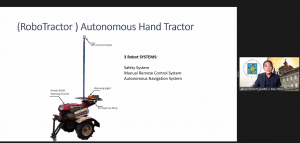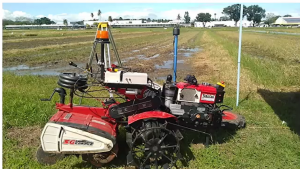Asst. Prof. Anthony James C. Bautista, Ph.D., the Acting Assistant Dean of the UST Faculty of Engineering, presented his project, “Agrotis: The Global Positioning System (GPS)-Guided Hand Tractor Robot for Rice Farming Applications,” on February 23, 2022, as a webinar speaker for the Smart Farming Technology Research Centre (SFTRC) of the Universiti Putra Malaysia (UPM).


Funded by the Department of Science and Technology (DOST) Philippine Council for Agriculture, Aquatic and Natural Resources Research and Development (PCAARRD) in 2020, the RoboTractor named Agrotis, which is the Greek word for farmer, had successful tests in navigation using Real-Time Kinematic (RTK)-GPS base station and initial land tillage operation in 2021. With his team of students at UST, Bautista was also able to present an initial working model to farmers at the Philippine Rice Research Institute.
Bautista, who was previously known for his Gregorio Zara award-winning Logistic Indoor Service Assistant (LISA) robot that minimized the exposure of the hospital staff to COVID-19 through remote communication and medicine delivery features, explained that the current Agrotis model has three main features. It has the safety system or emergency stop function; the manual remote-control system that allows manual control of the robots using radio signals; and the autonomous navigation system that will take care of the movement across the farm while the robot performs land tilling or other farming operations.
With an increasing Filipino population heightening the demand for rice but less young people considering farming as a career, the Agrotis project will improve the working conditions and tools in farms.
“But robots can never replace our farmers. These technologies only aim to make their jobs easier through efficiency and safety, which can give them more time to be with their family,” emphasized Bautista, who himself belongs to a family of farmers.
Currently, Bautista is working with the International Rice Research Institute (IRRI) to optimize the cost of the technology. They are also looking into the possibility of using small swarm robots for other farming operations, such as land mapping, leveling, crop spraying, and weeding.
“Agriculture 5.0 is fast approaching, and we really need to work harder together so that we can cope with the ever-advancing technology. The good thing is that these [machinery] are becoming more accessible and affordable. If this is the case, our next task is to prepare and aid our farmers in adapting these technological tools,” concluded Bautista.




